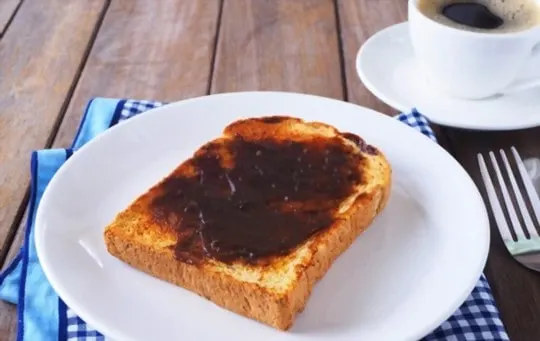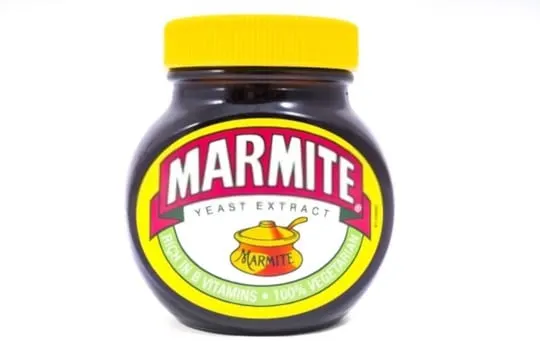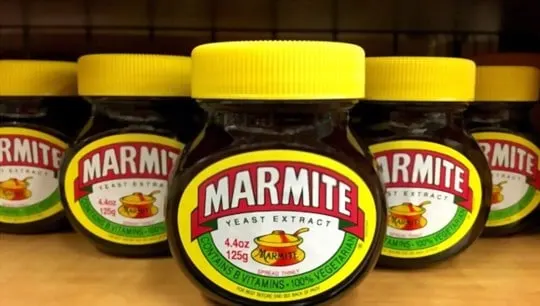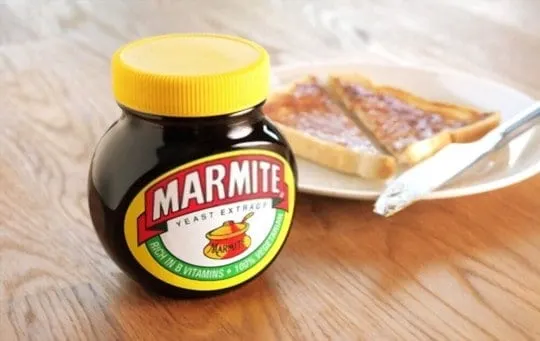Marmite is a savory spread with a unique flavor that can be enjoyed on toast, crackers, or sandwiches.
Some people love it, and others hate it for its strong flavor.
It’s made from yeast extract, which makes the spread taste salty and slightly sweet at the same time.
The consistency is often described as sticky, like honey or peanut butter.
But what does Marmite taste like, the ingredients, and where has this strange spread come from? The answer to these questions will surprise you.
What is Marmite?

Marmite is a British food that has been around since 1902, and it’s still as popular as ever.
Marmite contains salt, sugar, and yeast extract.
It was first created in the 1900s by scientists looking to create an inexpensive meat extract for people living on low incomes.
They added brewer’s yeast (a form of fungi) during this process, which resulted in Marmite – similar to other types of vegetarian meat products like Bovril or Oxo cubes.
The result is a thick paste with a salty taste that some describe as slightly sweet.
Others would say savory-bitter.
Its flavor is very much dependent on individual tastes and preferences.
The ingredients are spreadable at room temperature to be served anywhere from toast for breakfast to cheese sandwiches for lunchtime.
Marmite has become so popular that there is a Marmite museum devoted to its production in the UK.
Why Do People Love or Hate Marmite so Much?

It is not hard to see why people either love or hate Marmite with such a strong taste.
- It has been said that it is an acquired taste.
- The distinctive flavor of Marmite can be a love or hate thing, and many Britons find this inedible foodstuff hard to stomach.
- Some people cannot get past the intense salty taste on their tongue even if they have tried eating it repeatedly.
- It doesn’t matter how much honey you add; some will not like the flavor even after decades of trying to acquire a taste for it with no success.
However, for those lucky ones who enjoy its strong flavor that is so unique—it becomes something almost addictive.
You might start liking Marmite solely because your mom used to put some on toast when you were a child,.
But then, as you grow up and develop your tastes in food—you find yourself craving the stuff so much that it becomes an integral part of your diet.
You might start to eat Marmite liberally on everything from buttered toast to pasta with Bolognese sauce.
It doesn’t even sound too bad now after all is said and done.
People who love this flavor will put it on anything they can get their hands on because of its distinctive taste – whether it be cheese sandwiches or scrambled eggs for breakfast.
Marmite is not just for tea anymore.
No matter how hard some people try—they cannot acquire a taste for this product, which makes them wonder why it is so popular in the first place.
How to Use Marmite in Recipes?

Marmite is a yeast extract that has been used for decades as an ingredient in various British dishes.
However, it is also a perfect ingredient to use in other dishes because of its umami taste.
Marmite can be used as a flavoring for soups and sauces.
It adds depth and thickness to food which makes the flavor more complex.
Marmite has been used extensively overseas, so there are many different ways that you can utilize this wonderful product.
Here are some of the ways that you can use Marmite in your cooking:
- Marmite adds a whole new flavor profile to soups, sauces, and risottos. You can also drizzle it on top as well for added richness.
- If you want a more savory dish, then add Marmite into omelets or fried eggs before they cook.
- You can mix it with cream cheese to make an amazing spreadable dip that tastes great with crackers dipped inside.
- Add a teaspoon of Marmite to your baking recipes for a deeper, more savory flavor.
- Adding it into rice will add depth and make the dish much tastier. If you are looking for something specific, then try adding it to Jambalaya or Paella.
- It is also perfect as part of an appetizer platter with crackers before they go out at parties because its rich taste leaves people wanting more.”.
Marmite vs Vegemite

Marmite is a savory yeast extract spread that originated in the United Kingdom and New Zealand.
Vegemite, on the other hand, has Australian origins.
Both spreads are often used as condiments for breakfast toast or crumpets – but they have different tastes.
Marmite is a very salty spread and has a strong flavor.
Vegemite, on the other hand, is less salty with an earthy taste.
If you like saltiness, then Marmite would be for you.
But if savory isn’t your thing, then try Vegemite instead.
It’s not as salty, and it tastes more like toast than anything else – but remember to eat it sparingly because too much will make you feel sick or give you headaches.
What Does Marmite Taste Like? Does Marmite Taste Good?

Marmite is a type of food spread that’s made from yeast extract.
It can be described as salty, savory, and umami, which typically includes meat or vegetables.
It’s a liquid that has been thickened to the consistency of a paste.
The yeast extract used in marmite production gives it its unique taste; this can be seen in other types of spreads such as Vegemite and Bovril.
This means you may like one better than another, depending on your preference for these flavors.
Some people say they enjoy eating Marmite because it makes them feel more awake with an increased energy level after consuming the product.
Others don’t eat it at all since they find its distinctive flavor unappealing.
The flavor can be described as similar to soy sauce or Vegemite–a savory spread with an umami taste originating from Australia.
But unlike Vegemite, Marmite does not contain any salt because it is extra salty attribute comes from the yeast extract itself rather than sodium chloride (salt).
The most popular way to eat it is toast with butter because the two go together very well.
How to Store Marmite?

Originally used as an inexpensive way to add more flavor and protein to meals, Marmite is now widely enjoyed by Britons of all ages.
However, if you’re not a fan of the salty yeast extract, there is no need to worry.
There are many ways in which it can be stored without ruining its flavor and nutritional value.
One such way is storing Marmite upside down in an airtight jar or container, preferably kept away from direct sunlight so that harmful ultraviolet rays do not penetrate the jar.
Another method is to keep Marmite in a refrigerator, as it will stay fresh for longer periods due to lower temperatures and lack of light.
If you cannot refrigerate your Marmite, don’t worry because there are still many other ways that can be used, such as keeping it in a cool, dry place such as an unheated pantry or closet.
This will keep the jar of Marmite from getting too hot and help prevent condensation, which can be harmful to food products.
In addition, don’t store your container of Marmite near other foods with strong odors, as it may cause the Marmite’s flavor to be altered.
Where to Buy Marmite?
Marmite is typically found in the same aisle as peanut butter.
Due to the UK’s high consumption of this product, it is typically always stocked on the shelves.
It can be found in most grocery stores and even some convenience stores nationwide, so you should never have trouble finding a jar while shopping for groceries.
Marmite may also be online through Amazon or other retailers like Tesco Groceries Online Market Place.
Conclusion
In conclusion, Marmite is a type of yeast extract that is popular in many dishes.
If you are looking for where to buy Marmite, there are several stores and grocery stores worldwide that sell this product.
The taste of Marmite is unique and has an acquired taste.
It is a rich and savory flavor that tastes very strong, salty, and bitter.
If you are not used to this type of food, it may take some time to get used to the flavor before enjoying eating Marmite.

What Does Marmite Taste Like? Does Marmite Taste Good?
Ingredients
- Marmite
- Ingredients from your favorite recipes
Instructions
- Depending on the recipes you choose, the taste can vastly differ.
- For authentic results, it is important to choose a recipe that will highlight the original flavor.
- Have fun experimenting with different recipes and taste tests!
